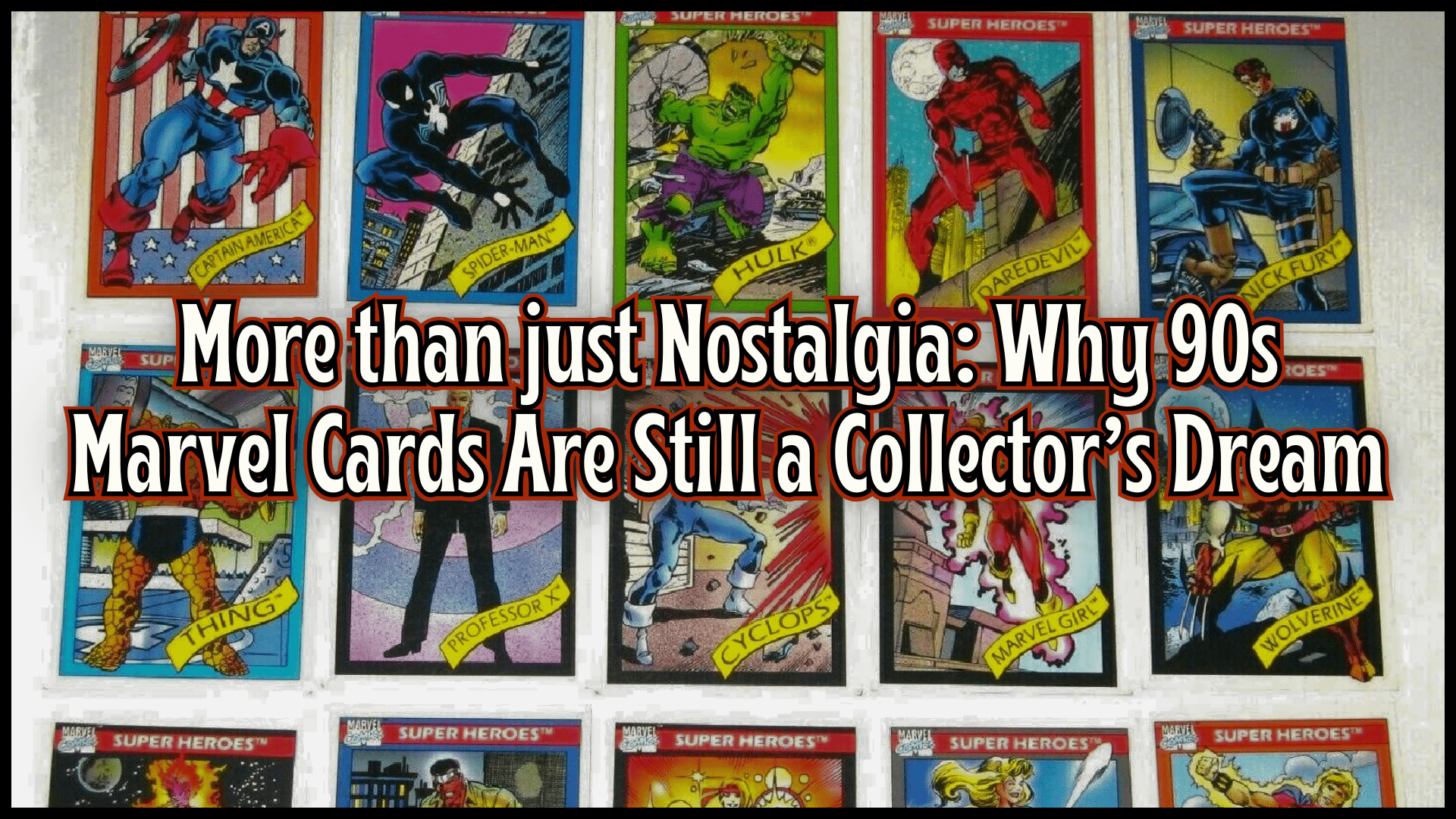Beyond Nostalgia: 90s Marvel Cards Are Still a Collector’s Dream
Do you remember the 90s Marvel cards that were sold alongside sports cards during the trading card boom?
In 1990, the “Marvel Universe Series I” set was sold seemingly everywhere and grabbed the attention of both hardcore and casual Marvel fans. Evidently, it also appealed to trading card collectors unfamiliar with the comic book company’s unique Super Heroes and Super-Villains.
In 2020-21, excitement for trading cards was rekindled. There was a surge in demand for cards like the Marvel cards people collected in the 90s. This rekindled feelings of nostalgia amongst collectors who remember collecting these cards back in the day.
This also led to some record-breaking resale prices and inflated auction pricing. However, prices quickly cooled off, as a number of 90s Marvel Cards were graded and listed alongside a flood of unopened surplus packs retrieved from storage.
While there are still a few bucks to be made off of some of these cards (depending on their rarity, condition, and cultural relevance), the real value of these cards has always been about how they expand their collector’s knowledge of the expansive Marvel Universe.
The cards spotlight Marvel’s core characters, and more interestingly, introduce the comic book company’s lesser-known characters as well.
In today’s Retro Review, we’re looking back at the history and legacy of the massively produced, mass appeal Marvel Universe Series I trading card set.
In the following article you will learn all about:
- Marvel cards in the context of the trading card industry in the early 90s
- The good, the bad, the rad, and not-so-rad, aspects of Marvel Universe Series I cards
- Some interesting and little-known facts about 90s Marvel cards
- The fluctuations in the market value of 90s Marvel cards over time
- Why Marvel Universe Series I trading cards remain relevant to this day
Context and History
Marvel Cards in the 90s
There were a number of trading card sets released by Marvel in the 90s. However, the set most remembered for it’s classic retro aesthetic and mainstream popularity is the Marvel Universe Series I set that was released in 1990.
The success of Series I, led Marvel to release four more Marvel Universe sets. Series II to Series V were released yearly over the course of the next four years between 1991 and 1994.
It is widely agreed amongst fans of Marvel cards, that the quality and appeal of the cards declined after Series II. By Series V, interest had waned significantly and the series came to an end.
While the Marvel Universe Series I set, was for many, the first Marvel cards they remember, Marvel had produced a number of sets prior to 1990. Marvel first published trading cards back in 1966.
The 1966 Marvel cards were produced by vintage trading card mainstay Donruss. But the 1990 Marvel Universe Series I set was produced by Impel (which later became SkyBox International).
Marvel special projects editor, Bob Budiansky was largely involved with the creation of the 90s Marvel Universe cards. Budiansky assigned the task of creating each card’s iconic artwork to a group of Marvel comic book artists. These artists had experience drawing the characters and understood the characters fairly well.
The artists’ personal connections to the Marvel Universe shines through their artwork, effectively captureing the true essence of each character.
Marvel Universe Series I Trading Cards
The initial Series I Marvel card set consisted of 167 cards, including 5 hologram cards.
The Artists Behind 90s Marvel Cards
Each character card features a member of the Marvel Universe depicted in stunning original artwork on the front. Arthur Adams, Jim Lee, Tom Morgan and Ron Frenz, were all involved in creating the highly attractive artwork on each card.
These artists were all paid competitive rates to create small-scale artworks that mimicked the style of comic book covers. This incentivized the creation of quality works of art that bestowed the love that both artists and fans had for the characters.
The Stats On the Back
The back of each character card included a short bio, the character’s real name and first appearance. It also listed each character’s battle stats, including wins, losses, and ties.
The set features a number of unique “Super Heroes” and “Super-Villains” cards. It also includes some “Rookie” cards, introducing casual fans to relatively new Marvel characters.
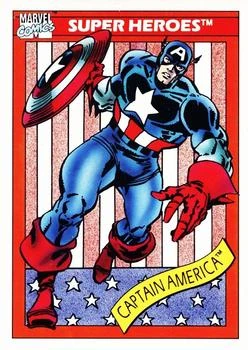
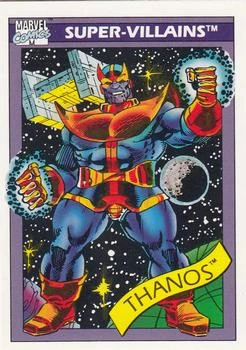
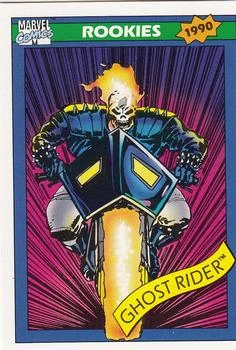
There are also 36 cards featuring “Famous Battles,” 11 cards featuring iconic comic book covers, and a few “Team Pictures”.
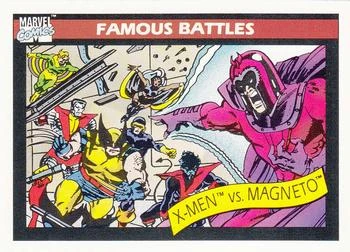
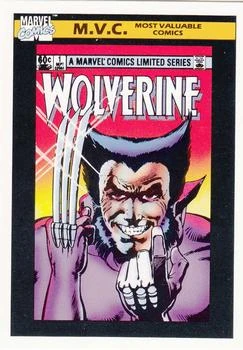
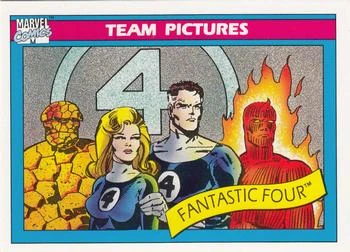
And we can’t forget about the Stan “the Man” Lee card. This is the only card depicting the father of Marvel in any of the 5 Marvel Universe Series sets from the 90s.

90s Marvel Cards were like Encyclopedias
In a way, the set was like a Marvel encyclopedia. It contained character biographies and historical records of significant events from within the Marvel Universe. A few years ago, the late Michael Pasciullo, who worked on Series I as Assistant Marketing Manager, told Marvel.com:
“It almost became a game to see how deep into the well you could go” when considering who and what would be featured on each individual card.”
Marvel.com Interview published November 25, 2014
According to Pasciullo, the creators of the set intended the cards to be a deep-dive into the Marvel Universe. The cards would then expand fans knowledge of fan favourites and lesser-known characters.
In that same interview, Pascuillo reminds us that these cards were produced during the pre-internet days.
“…the best part was that this was about two years before the Internet hit, so we were doing this all from our own personal reading experiences. You couldn’t simply Google ‘Spider-Man Villains.'”
Marvel.com Interview published November 25, 2014
The cards fulfilled a significant function for Marvel fans who desired a go-to resource that catalogued Marvel’s heroes, villains, and important events.
The Comic Book Industry in 1990
The late 1980s and early 1990s witnessed the rise of the speculator market in comic books. Collectors purchased multiple copies of issues they believed would increase in value, often those with major character introductions, deaths, or special covers.
This brought in new fans but also led to inflated print runs and artificial demand.
This era saw the introduction of some significant characters and storylines that would have lasting impacts. Marvel introduced characters like Gambit and updated stories and styles in ways that appealed to long-time fans and new readers. Ghost Rider and Deathlok are examples of new characters taking over existing personas.
The late 1980s to early 1990s also saw an increase in the popularity of graphic novels and trade paperback collections. This format brought comic book storytelling to mainstream bookstores, expanding the audience beyond traditional comic book shops.
Improvements in printing technology allowed publishers to produce comics with better quality inks and papers. They also allowed publishers to create more sophisticated cover art, including embossed or holographic covers, which became popular among collectors.
Niche vs. Mainstream Appeal
Niche Appeal
Within the comic book community, the niche appeal was sustained by the depth and complexity of stories and character developments. Long-time fans appreciated the continuations and crossovers of elaborate universes.
Comic book conventions and local comic shops fostered a close-knit culture that thrived on detailed knowledge of comic lore and collecting rare issues.
Mainstream Appeal
The early 90s marked a significant pivot towards mainstream appeal. This was driven by major comic book companies tapping into broader entertainment avenues.
The success of movies and television shows based on comic book characters (most notably the 1989 “Batman” movie and its sequels) helped propel comic characters into the wider public consciousness.
Merchandising, including toys, clothing, and especially trading cards, also played a significant role in this expansion.
Post-1990 Developments
Market Crash
The mid to late 1990s saw the comic book industry crash, largely due to the unsustainable practices of the speculator boom.
Sales plummeted as the market became oversaturated with too many titles and variants. Many collectors left the hobby when it became clear that most modern comics were unlikely to hold their speculative values.
Resurgence and New Media
Post-2000, the industry saw a resurgence, aided by the rising popularity of comic book adaptations in cinema. This started with movies like “X-Men” (2000) and “Spider-Man” (2002).
These movies revived interest in classic characters and also introduced comic book narratives to a global audience, further blending the niche and mainstream aspects of comic culture.
The trading card scene in 1990
The early 1990s marked a peak in the popularity of trading cards, partly driven by the booming interest in sports cards and expanding into non-sports cards, including comics and entertainment-related series.
The release of the Marvel Universe Series I cards capitalized on the growing collector’s market for trading cards. The trading card market in 1990 was part of a larger collectibles boom, which was highly profitable but led to a market bubble.
This bubble eventually burst in the mid-90s, but in 1990 the industry was at a high point. Trading cards during this era were targeted not just at children but at adults as well, with manufacturers recognizing the financial potential of adult collectors looking to invest in rare and limited-edition cards.
Advances in printing technology allowed for higher quality and more intricately designed cards, including features like foil stamps, embossing, and better quality holograms. These all helped drive the appeal of new sets released in 1990.
Key 90s Marvel Cards and Their Valuations
90s Marvel cards are highly collectible, with prices for mint condition cards reaching over $100.
The 1990 Series I Marvel cards are especially valued, with GEM-MT condition (near perfect) cards selling for four figures at auction.
Values of the special holographic cards like Cosmic Spider-Man are rare to find in GEM-MT (near perfect) condition. When when they are discovered, they can be extremely valuable.
In 2021, a PSA 10 (GEM-MT) Cosmic Spider-Man Hologram card sold for $4,500 at auction!
However more common PSA 8 and 9 graded Cosmic Spider-Man holograms are currently only selling for $150 – $200 at auction.
Card #28 in the set Marvel Universe Series I set features Aunt May (Spidey’s primary caregiver). The card includes some “unique” stats such as the number of pies baked (984) instead of battles fought, and the number of wrinkles on her face.
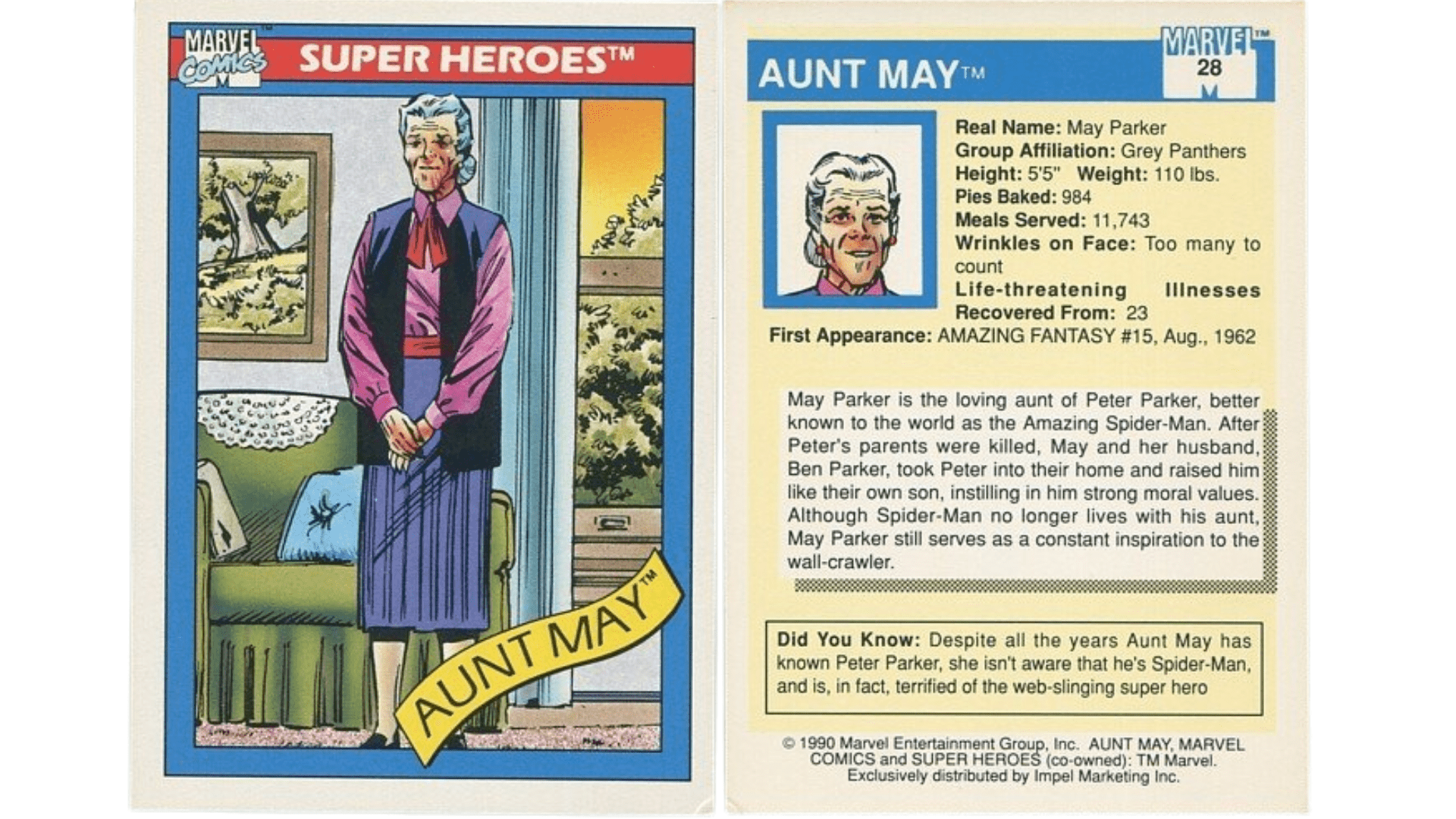
How the Value of Trading Cards are Determined
Determining the value of trading cards typically involves 3 steps:
1) Authentication
The card needs to be authenticated (scrutinized by a subject-matter expert), to prove that it is what it claims to be and is not a fake, a reprint, or a reproduced copy of its original.
2) Grading
After being authenticated, the condition of the card is assessed using a scoring system. Normally each score is a number out of 10. Each number represents a specific criteria of uniquely defined conditions that describe the card. A score of 10 is the most desirable in terms of reflecting the near perfectness of the card.
The Professional Sports Authenticator (PSA) is the biggest and most reliable third-party authentication and grading company of trading cards. The PSA grading system includes the following definitions:
PSA 10 (GEM-MT): “A PSA 10 card is a virtually perfect card. Attributes include four perfectly sharp corners, sharp focus and full original gloss. A PSA 10 card must be free of staining of any kind, but an allowance may be made for a slight printing imperfection, if it doesn’t impair the overall appeal of the card. The image must be centred on the card within a tolerance not to exceed approximately 55/45 ro 60/40 percent on the front, and 75/25 on the reverse.”
PSA 9 (MINT): “A PSA 9 is a superb condition card that exhibits only one of the following minor flaws: a very slight wax stain on reverse, a minor printing imperfection or slightly off white borders. Centering must be approximately 60/40 to 65/35 or better on the front and 90/10 or better on the reverse.”
PSA 8 (NM-MT): “A PSA 8 is a super high-end card that appears PSA 9 at first glance, but upon closer inspection, the card can exhibit the following: a slight wax stain on reverse, slightest fraying at one or two corners, a minor printing imperfection, and/or slightly off-white borders/ Centering must be approximately 65/35 to 70/30 or better on the front and 90/10 or better on the reverse.”
And so on…
PSA Standards
3) Appraisal
After cards have been authenticated and graded by a reputable third party authenticator, a professional appraiser can provide some guidelines on what the value of the card is worth at that specific time.
Generally, the higher the card grade, the higher its value. However, a number of secondary factors affect card value as well. These factors include: the availability of the card, the current demand/interest in the card, and/or the interest in the character. The uniqueness of the card also affect its value. Hologram cards, chase cards, limited edition cards, and rookie cards tend to be worth more.
It is important to note that the trading card market experiences volatility and is subject to drastic market fluctuations. The valuation of a card today, doesn’t necessarily reflect the value of that card in the future.
The “Real Value” of Marvel Cards to Marvel, and to Marvel Fans
Collecting Marvel cards is driven both by financial value and by personal affinity for specific characters or series.
Around the time “Black Panther: Wakanda Forever” hit the big screen in 2022, there was a surge in interest in Black Panther memorability. This surge temporarily inflated the value of the Marvel Universe Series I Black Panther card.
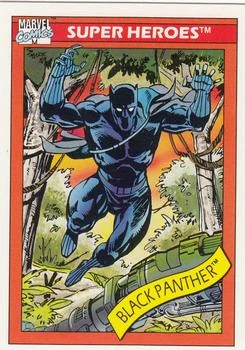
That year, a PSA 10 (GEM-MT) Series I Black Panther card sold for $4,500 at auction!
A certain character or card can mean something to someone for any number of unique personal reasons. The value of these cards may be higher in terms of personal nostalgia than the market value of the card.
When these cards were released, Marvel was banking on fans speculating about the future value of the cards. It was also hoping to cash in on fans interest in trying to find their favourite characters.
Marvel Universe Series I Cards were the Gateway to Unexplored Comic Book Awesomeness
For Marvel, this particular set of cards was really important at introducing new characters to new fans. Each card effectively serves as a commercial or sneak peak of the comic book issues containing that character.
The cards featured detailed statistics and facts about characters, which added educational value.
Each card was like its own little story unto itself.
A pack of 90s Marvel cards contained 12 unique stories that inspired curious imaginations to run wild. Cards inspired fans to dream. For some people, buying a pack of cards was more appealing than buying a comic book because the comic book might only contain a few characters and only tell one story, or part of a story.
90s Marvel Cards were Primers for The MCU
Movies from the Marvel Universe wouldn’t start to be worthy of the iconic characters and storylines that they depicted until around 10 years after the release of the Marvel Universe Series I cards.
From 2000 on, starting with the release of the first “X-Men” movie and later with the “Iron Man” Movie (2008) and the Marvel Cinematic Universe movies that followed, a number of the characters we were first introduced to through 90s Marvel cards started to make waves on the big screen.
The popularity of the Marvel Universe Series I cards proved to Marvel that their characters and stories not only appealed to a niche comic book fanbase, but also appealed to mainstream pop culture enthusiasts.
The Not-So-Rad Aspects of 90s Marvel Cards
The beloved Marvel Universe Series I trading cards are not without their flaws.
Because of the mass production of these cards, a number of the cards were produced that include printing errors. A number of cards appear off-center or have ink discolourations and off-white borders.
Some also consider the mass quantities detrimental to creating a lucrative collector’s resale market which relies on scarcity to drive up value and auction prices.
However, many people argue that this is a good thing, because it keeps prices low and ensures more people have access to the cards. Most base cards of a PSA 8 rating can still be purchased for a few dollars, making it viable for late-comers to start collecting, or for people to be able to now complete the sets they started collecting back in 1990.
The battle stats on the back of each card provided hours of entertainment for fans. People compared stats between characters and sought to find out which character had the most battles fought, most wins, most losses and highest win percentage.
Unfortunately though, it would come to light soon after the foil was cracked open on the first few packs of Series I, that these stats were bogus. They were totally made up by card creators! This scandalous revelation dispelled the myth that Dagger of the duo: Cloak and Dagger, had the highest win rate (73%).
The Legacy of Marvel 90s cards:
We discussed earlier that the Marvel Universe Series I cards helped attract new audiences to the fandom. Marvel was able to retain a number of these new fans as is evident by observing the success of the Marvel Cinematic Universe Movies and TV series amongst the demographic of people who lived through the era of Marvel Universe trading cards.
Although the popularity of trading cards and comics would decline towards the end of the 90s, these cards demonstrated that people were indeed interested in collecting Marvel cards, particularly rare and limited numbered cards like the holographic cards.
In the years since 1990, Marvel has released a number of limited edition, specialty cards and sets, that have garnered the interest of avid collector’s, investors, and hardcore fans.
Some of these cards, such as a number of cards from various sets of the Marvel Masterpiece series consistently fetch prices over $1000 at auction.
The success of the 90s Marvel cards proved that collecting comic book cards could rival mainstream/traditional sports card collecting.
This helped fringe comic fans find new places within the broader pop cultural landscape. It also helped popularize the Marvel brand, its Super Heroes, and Super-Villains. It wouldn’t be until many years later, with the beginning of the Marvel Cinematic Universe (MCU), that the brand’s popularity would soar again.
Conclusion:
The Marvel Universe is awesome! It’s fandom is dedicated, and is also eager to welcome new members, such as those who find their way to Marvel through collecting trading cards.
The Artwork, the classic sports card looking appearance, and inclusion of key statistics and biographical information all combined to endear the Marvel Universe Series I cards to new and existing Marvel fans and trading card collectors.
Personally, I spent a good chunk of my time (and my allowance) on these cards back in the day. They never ceased to entertain and inspire curiosity about the characters depicted on each smooth, glossy coated cardboard trading card.
While the value of these 90s Marvel cards as an investment strategy or as rare vintage collectible items fluctuates over time, the intrinsic value found in flipping through them to review the wealth of information about each character, and the nostalgia that they trigger, make them highly valuable in more than just monetary ways to the people who love them.
Reader Engagement:
Ok. That was a long article. If you’re still here, then you just might be as pumped about reflecting back on these 90s Marvel cards as I am!
But “‘nuff said” (at least by me).
Now, it’s your turn to share your experience with these cool cards from way back in our shared history. Were you a collector back in the day, or did you get hooked in the years that followed? Which card was your fave?
I’d love to hear all about your Marvel cards! Please leave a comment below and participate in the discussion.
Thanks for stopping by.
Have a rad rest of your day.
Further Reading:
For a detailed examination and more comprehensive information, you can refer to these original sources that cover elements of the Marvel Universe Series I trading cards:
- Den of Geek’s article on Marvel Cards
- SKTCHD’s article on the impact of Marvel Universe Cards
- Wikipedia entry on Marvel Universe Cards
- Marvel Fan Wiki entry in Marvel Universe Series I Cards (includes images of each card!)
FAQ
What makes the ’90s Marvel Universe Series I cards so collectible?
The ’90s Marvel Universe Series I cards are highly collectible due to their nostalgic value, unique artwork by renowned artists, and their role in introducing a wide array of Marvel characters. Their mass production and appeal during the trading card boom of the early ’90s also contribute to their lasting legacy.
How have the values of ’90s Marvel cards fluctuated over time?
The values of ’90s Marvel cards have seen significant fluctuations, driven by nostalgia and market trends. Key cards, especially in mint condition, have reached high auction prices, though the market cooled after a surge in 2020-21, reflecting the volatile nature of collectibles.
What was unique about the artwork on the ’90s Marvel cards?
The artwork on 90s Marvel cards was distinctive for its high quality and comic book style, created by top artists who brought each character’s persona to life. This has made the cards highly appreciated not just as collectibles but also as miniature art pieces.
How do professional graders assess the condition of 90s Marvel cards?
Professional graders like PSA assess cards based on several criteria, including corner sharpness, glossiness, colour vibrancy, and centering. Cards are graded on a scale from 1 to 10, with higher scores indicating better condition and potentially higher value.
Why do collectors value ’90s Marvel cards beyond their monetary worth?
Collectors value 90s Marvel cards not only for their potential as investments but also for their personal and nostalgic significance. These cards often represent fond memories from childhood and a deeper connection to the Marvel Universe.
Craig is a partner, and proud father of a teenage daughter, and two dogs. He's an avid blogger who loves researching and discussing 80s and 90s nostalgia. When not working on his website or hanging with his fam, Craig enjoys playing guitar, watching lacrosse, and being near water.

